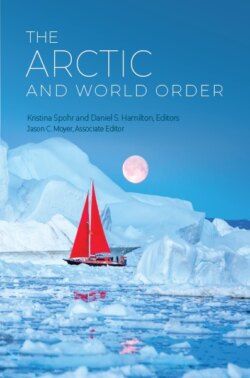Читать книгу The Arctic and World Order - Группа авторов - Страница 26
На сайте Литреса книга снята с продажи.
Future Horizons
ОглавлениеLooking forward with some speculation, we can see divergent paths. One path might be imagined in the following way: by 2040, sea ice may have disappeared one summer. Perhaps shipping has increased in volume and in length of season, possibly including year-round voyages by ice-strengthened vessels. The Central Arctic Ocean Fisheries Agreement will have run its initial 16-year term—perhaps to be renewed, perhaps to be replaced by a regional fisheries management organization as exploitation begins. There are likely more mines and perhaps more oil and gas fields, depending on the state of renewable energy worldwide.35 Perhaps India has joined China as a rising force in Arctic affairs as in global affairs. With luck, today’s institutions concerned with the Arctic may have been strained but have not broken, thanks in part to the efforts of countless people to create ties across borders, develop a vision for the Arctic, and promote continued cooperation and mutual understanding. Conservation continues to be a challenge, but ecosystems and species have a chance at adapting to the ever-transforming climate. Indigenous peoples continue to sustain their own identities and ways of life and to pass on cultural traditions and values from one generation to the next.36 We look to 2060 with cautious optimism.
Without that luck, without that commitment to sharing an abundant Arctic, without the hard work of people in and alongside Arctic institutions, the second potential path to 2040 will be a very different story. Climate change will have affected nearly all aspects of life in the Arctic, exacerbated by poor management decisions driven by short-term, localized thinking. Shipping will be regulated to some degree by the IMO and its Polar Code, but enforcement is lax and accidents all too common. Arctic resources are available to the highest bidder, with little concern for environmental and cultural effects. Fish stocks have been plundered and yield a fraction of the catch they once supported. What’s more, fish and other marine life might be contaminated by microplastics with serious implications for human health.37 Today’s institutions have buckled and many no longer exist. Countries espouse cooperation even as they ignore the needs of their neighbors. Ecosystems are now shaped by human influence and conservation is a matter of preserving remnants of what once was. We look to 2060 and wonder what will be left.
The difference between these scenarios for 2040 is the reason that institutions matter, that the work of those involved in Arctic institutions matters, and that those of us who wish for something close to the first path laid out above must continue to fight for an Arctic characterized by abundance, cooperation, and an ever greater awareness of our responsibility to make decisions that are sound for the long-term, in a changing environment, across the full range of human activities. Today’s choices will determine what the Arctic is like in two decades’ time and beyond.38 The path our society is on may avoid major disasters,39 but by the same token, it involves an endless series of compromises made near and far, which together continue to degrade the Arctic. Finding a new path will not be easy in the face of inertia and active opposition from businesses and governments alike – all of which are more or less keen to exploit natural resources, to keep the economy buzzing, and to ensure their countries are at the forefront of industrial and technological progress. Yet, if in the process the environment is irrevocably damaged and degraded, living with the results of poor choices is likely to be even harder and costlier in human and economic terms.
